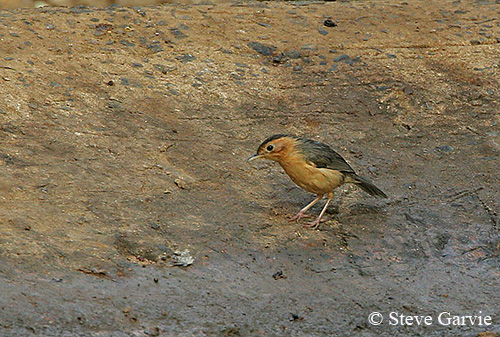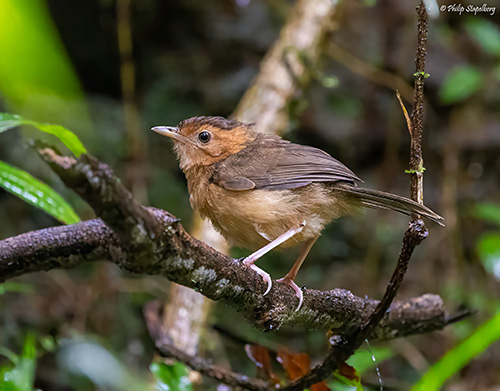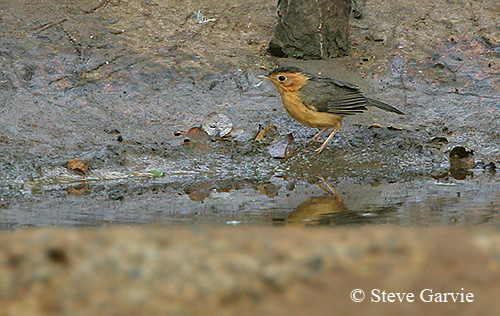
Fr: Akalat à calotte brune
Ang: Brown-capped Babbler
All: Braunscheitel-Erddrossling
Esp: Tordina Coroniparda
Ita: Garrulo capobruno
Nd: Bruinkapjungletimalia
Sd: ceylontimalia
Photographers:
Steve Garvie
RAINBIRDER Photo galleries
Philip Stapelberg
GALLERY
Alan & Ann Tate
AA Bird Photography
Text by Nicole Bouglouan
Sources:
HANDBOOK OF THE BIRDS OF THE WORLD Vol 12 by Josep del Hoyo-Andrew Elliott-David Christie - Lynx Edicions - ISBN: 8496553423
Birds of the World - Family Pellorneidae
Structure and Diversity of Vocalisation of an Endemic Forest Bird (Brown-Capped Babbler Pellorneum fuscocapillus) Across the Climatic Gradient in Sri Lanka
Wikipedia, the free encyclopaedia
Home page
Page Passeriforme Order
Brown-capped Babbler
Pellorneum fuscocapillus
Passeriformes Order - Pellorneidae Family
INTRODUCTION:
The Brown-capped Babbler is endemic to Sri Lanka where two subspecies share the range.
It is resident and lives in forest undergrowth and thick scrub. It is mainly a mountain species, usually found around 1,500 metres of elevation.
It feeds on insects and worms usually caught on the ground among the leaf litter or by searching in the low canopy, often in pairs or in small groups.
The Brown-capped Babbler builds the nest close to the ground, an open, cup-shaped structure or a loose ball with lateral entrance, placed among dead leaves or in tree hollow near the ground, or even in crevice in bank, usually concealed in dense vegetation. Both adults share the nesting duties.
The Brown-capped Babbler is widespread throughout the island and described as common. The species is not globally threatened at the moment.
DESCRIPTION OF THE BIRD:
Biometrics:
Length: 16-16,5 cm
Weight: 30 g
The Brown-capped Babbler has brown plumage above and bright cinnamon below.
The nominate race has dark brown upper mantle with pale buff shafts. Rest of upperparts is mid-brown.
On the upperwing, the fringes of the outer primaries are paler whereas the primary coverts are darker.
The fairly long, square-tipped tail is like the upperparts but with pale buff tip. It is often held upright.

Underparts and head sides are bright cinnamon. The breast sides are streaked mid-brown. The colour of the underparts may vary, being sometimes paler on mid-belly.
On the head, crown and nape are rich brown, and contrast with the upperparts. The throat is buff or pale yellow.
The bill is bluish-grey with paler lower mandible. It is slender and slightly curved, well-adapted for foraging or probing into crevices.
The eyes are dark brown to reddish-brown, surrounded by distinct, pale eyering.
Legs and feet are pinkish-brown.
Male and female are similar.
The juvenile is much paler overall, especially on the underparts. Some pale streaks are visible on the brown crown.
The young male has pale, reddish-yellow iris.
SUBSPECIES AND RANGE:
The Brown-capped Babbler has two subspecies. Generally, the birds living in the wet zone are much darker than those of the dry zone. It is present throughout the island, except the extremely dry Northern and South-eastern regions.
P. f. fuscocapillus (described above) occurs in the wet zone and wet hill area of SW and C of Sri Lanka.
P. f. babaulti is found in the arid lowlands of the dry zone of N and E Sri Lanka.
This race is paler overall, with greyer upperparts and paler underparts than nominate. The crown appears slightly browner.
HABITAT:
The Brown-capped Babbler is mainly found in dense thickets and well-wooded country, favouring the dense undergrowth of moist deciduous forests and secondary growths. It can also be seen near villages surrounded by overgrown land.
It is primarily a mountain species that occurs rarely below 1,500 metres of elevation in the central hills.
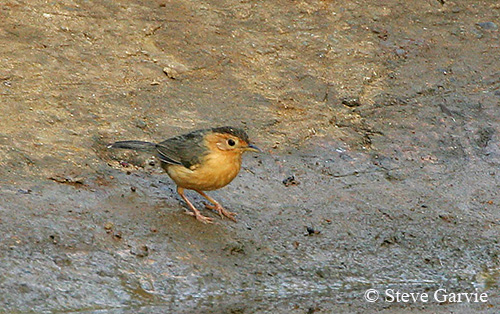
CALLS AND SONGS: SOUNDS BY XENO-CANTO
Often seen in pairs or small groups, these birds usually have a highly vocal behaviour. They communicate by vocalizations also used to establish the territories. This noisy species is more often heard than seen.
The Brown-capped Babbler is a skulking bird, but it is easy to locate thanks to its distinctive call, very similar to the words “pretty-dear”.
The alarm call is a sharp “wip” or a rapid “quit-it-it”, and we can also hear a scolding sound, a low “chr chrr chrr”.
The sustained, low-intensity song is a series of melodious whistles monotonously repeated. This song often echoes through the forest as a beautiful symphony of notes.
BEHAVIOUR IN THE WILD:
The Brown-capped Babbler feeds mainly on insects, including large beetles, but worms and some seeds are taken too.
Insects and seeds are picked from shrubs and on the ground where the bird moves by walking, hopping and running. Insects are caught among the leaf litter, by turning over the dead leaves.
The Brown-capped Babbler usually occurs in pairs on the forest floor, or in small groups. They communicate by vocalizations.
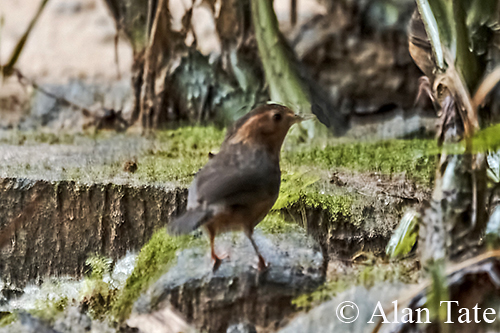
This species nests in a dome-shaped structure built on or near the ground, concealed in the undergrowth where it is practically impossible to find it. The nest-site is in deep forest, often at the base of a tree. Both adults take part in nesting duties. They are monogamous.
The Brown-capped Babbler is resident in Sri Lanka.
The short, rounded wings only allow a weak flight.
REPRODUCTION OF THIS SPECIES:
The breeding season takes place in February-April and September-December, but mainly in March-April, and usually during the rainy months.
The nest of the Brown-capped Babbler is built close to the ground, often close to opening or footpath. It is concealed among the dense undergrowth often at foot of large tree, sometimes under a bush or in decayed tree hollow near the ground, usually up to 1 metre above the ground.
The nest is a loose ball with a large lateral entrance, or occasionally a cup-shaped structure. It is made of grass, dead leaves, moss and twigs, and the cup is lined with dead leaves and fine fern stalks. Both adults build the nest.
The female lays 2-3 (mainly 2) whitish eggs with light brown speckling and some shade of brown. Both adults share the incubation lasting 10 to 15 days (more information is needed). The chicks are fed by both parents and remain at nest for 10-14 days before fledging.
